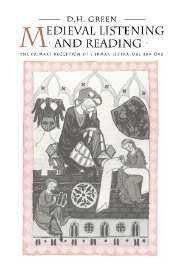Book contents
- Frontmatter
- Contents
- Preface
- List of abbreviations
- PART I Preliminary problems
- PART II Three modes of reception
- Introduction
- 3 Criteria for reception by hearing
- 4 Survey of reception by hearing
- 5 Criteria for reception by reading
- 6 Survey of reception by reading
- 7 Criteria for the intermediate mode of reception
- 8 Survey of the intermediate mode of reception
- PART III Conclusions
- Appendix Middle High German ‘lesen’ = ‘to narrate, recount, tell’
- Notes
- Bibliographical index
- Index of names
3 - Criteria for reception by hearing
Published online by Cambridge University Press: 04 September 2009
- Frontmatter
- Contents
- Preface
- List of abbreviations
- PART I Preliminary problems
- PART II Three modes of reception
- Introduction
- 3 Criteria for reception by hearing
- 4 Survey of reception by hearing
- 5 Criteria for reception by reading
- 6 Survey of reception by reading
- 7 Criteria for the intermediate mode of reception
- 8 Survey of the intermediate mode of reception
- PART III Conclusions
- Appendix Middle High German ‘lesen’ = ‘to narrate, recount, tell’
- Notes
- Bibliographical index
- Index of names
Summary
Recent work on the differences between the spoken and the written word has sharpened our understanding of the different types of communication and transmission which these two modes involve. Goody sums up these differences by saying that writing changes the channel of communicated language from auditory to visual: we hear speech and see writing; we speak with the mouth and listen with the ears, whereas we write with the hand and read with the eyes. Since in this chapter we shall be concerned with evidence for hearing the spoken word we may start with the features of oral communication and transmission.
Oral communication presupposes a speaker and at least one listener at the same time and at the same place; together they constitute a group (as distinct from the individual writer or reader) which, because of its physical presence on the same occasion, can rely on deictic pointers to what is clear to both parties in order to reinforce the communication. Since both parties share the same visual and acoustic space they are open to non-verbal communication: visual in the form of miming or gestures, acoustic in the shape of intonation or accentuation (aspects which cannot be conveyed in writing except by verbal additions or by postmedieval typographic devices such as italics or exclamation marks). In that oral communication depends on the presence of both parties potential dialogue is always there, ranging from explanations given by the speaker in response to a look of incomprehension on his listener's face to interruptions from the latter.
- Type
- Chapter
- Information
- Medieval Listening and ReadingThe Primary Reception of German Literature 800–1300, pp. 61 - 94Publisher: Cambridge University PressPrint publication year: 1994



